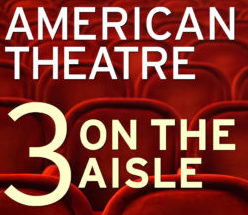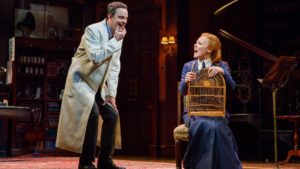 A 1958 kinescope of an unidentified telecast of part of Carol Burnett’s standup comedy routine:
A 1958 kinescope of an unidentified telecast of part of Carol Burnett’s standup comedy routine:
(This is the latest in a series of arts-related videos that appear in this space each Monday, Wednesday, and Friday)
Terry Teachout on the arts in New York City
 The latest episode of Three on the Aisle, the twice-monthly podcast in which Peter Marks, Elisabeth Vincentelli, and I talk about theater in America, is now available on line for listening or downloading.
The latest episode of Three on the Aisle, the twice-monthly podcast in which Peter Marks, Elisabeth Vincentelli, and I talk about theater in America, is now available on line for listening or downloading.
In this episode, Peter, Elisabeth, and I chat together about a wide-ranging assortment of topics:
This week starts with the subject of whether some shows are too hopelessly dated to be brought back. What prompted this? The Broadway revival of Children of a Lesser God, which they agree is not very good, as director Kenny Leon seemed unsure of how to handle Mark Medoff’s now-period piece about the conflict between the Deaf and hearing communities. Ironically, they point out that Angels in America, which ostensibly treats more topical issues, actually fares better as a timeless work….
Next is a (too-brief) overview of their picks for summer events all around the country. Terry chooses American Players Theatre in Wisconsin for its exquisite setting and on-point curating…
Then the critics host their first ever mailbag segment! Elisabeth goes through recent questions from listeners….
We wrap up the episode by discussing other shows that we’ve seen lately.
To listen, download the episode, read more about it, or subscribe to Three on the Aisle, go here.
In case you missed any previous episodes, you’ll find them all here.
Few of us are destined to be remembered very clearly or very often, save by our nearest and dearest. We know this in our bones, which is why some monied folk seek to elude the anonymity of the ever-beckoning grave by pasting their names on concert halls or museum wings. For those of us who have done less well in life’s lottery, there is always the elaborately planned funeral….
Read the whole thing here.
 “Looking back, I see that only a very little time ago I was greatly concerned about my memory of H. and how false it might become. For some reason—the merciful good sense of God is the only one I can think of—I have stopped bothering about that. And the remarkable thing is that since I stopped bothering about it, she seems to meet me everywhere. Meet is far too strong a word. I don’t mean anything remotely like an apparition or a voice. I don’t mean even any strikingly emotional experience at any particular moment. Rather, a sort of unobtrusive but massive sense that she is, just as much as ever, a fact to be taken into account.
“Looking back, I see that only a very little time ago I was greatly concerned about my memory of H. and how false it might become. For some reason—the merciful good sense of God is the only one I can think of—I have stopped bothering about that. And the remarkable thing is that since I stopped bothering about it, she seems to meet me everywhere. Meet is far too strong a word. I don’t mean anything remotely like an apparition or a voice. I don’t mean even any strikingly emotional experience at any particular moment. Rather, a sort of unobtrusive but massive sense that she is, just as much as ever, a fact to be taken into account.
“‘To be taken into account’ is perhaps an unfortunate way of putting it. It sounds as if she were rather a battle-axe. How can I put it better? Would ‘momentously real’ or ‘obstinately real’ do? It is as if the experience said to me, ‘You are, as it happens, extremely glad that H. is still a fact. But remember she would be equally a fact whether you liked it or not. Your preferences have not been considered.’”
C.S. Lewis, A Grief Observed
 A rare kinescope of Dick Haymes singing “Come Rain or Come Shine,” by Harold Arlen and Johnny Mercer, on Stage Show, originally telecast by CBS on October 1, 1955. He is accompanied by the Dorsey Brothers Orchestra:
A rare kinescope of Dick Haymes singing “Come Rain or Come Shine,” by Harold Arlen and Johnny Mercer, on Stage Show, originally telecast by CBS on October 1, 1955. He is accompanied by the Dorsey Brothers Orchestra:
(This is the latest in a series of arts-related videos that appear in this space each Monday, Wednesday, and Friday)
In today’s Wall Street Journal I review Lincoln Center Theater’s new Broadway revival of My Fair Lady. Here’s an excerpt.
* * *
Of all the great Broadway musicals of the postwar era, “My Fair Lady” is the only one that takes a major work of literature, George Bernard Shaw’s “Pygmalion,” and turns it into an equally distinguished musical that is true to the spirit and letter of its source material….
 For this reason alone, it’s appropriate that Lincoln Center Theater, which is as well known for its musical-comedy revivals as it is for its productions of the plays of such noted modern dramatists as John Guare and Tom Stoppard, should now be mounting the fourth Broadway revival of “My Fair Lady,” which was last seen in New York in 1994. Nor would anyone reasonably expect LCT to offer the kind of radical transformation of so beloved a musical that Bedlam recently gave us in its small-scale “Pygmalion” (which closes on Sunday, if you haven’t seen it yet). Instead, Bartlett Sher, the director, has mounted “My Fair Lady” in the now-familiar manner of his hugely and deservedly successful LCT revivals of “South Pacific” and “The King and I.” Like its predecessors, it’s a very big show, with elaborate costumes, a full-sized pit orchestra, a Turneresque drop portraying Vicwardian London and a star, Lauren Ambrose, who is famous for her TV work but is also a stage performer of the first rank.
For this reason alone, it’s appropriate that Lincoln Center Theater, which is as well known for its musical-comedy revivals as it is for its productions of the plays of such noted modern dramatists as John Guare and Tom Stoppard, should now be mounting the fourth Broadway revival of “My Fair Lady,” which was last seen in New York in 1994. Nor would anyone reasonably expect LCT to offer the kind of radical transformation of so beloved a musical that Bedlam recently gave us in its small-scale “Pygmalion” (which closes on Sunday, if you haven’t seen it yet). Instead, Bartlett Sher, the director, has mounted “My Fair Lady” in the now-familiar manner of his hugely and deservedly successful LCT revivals of “South Pacific” and “The King and I.” Like its predecessors, it’s a very big show, with elaborate costumes, a full-sized pit orchestra, a Turneresque drop portraying Vicwardian London and a star, Lauren Ambrose, who is famous for her TV work but is also a stage performer of the first rank.
If you’ve been eagerly waiting for Ms. Ambrose to return to the New York stage ever since she stole the show from Susan Sarandon nine years ago in “Exit the King,” you’ll be happy to hear that she’s a knockout and a wow….
I’ve seen more dramaturgically adventurous revivals, most notably at the Oregon Shakespeare Festival in 2013 (where Amanda Dehnert staged the show in the style of Brecht) and at Boston’s Lyric Stage in 2015 (where it was mounted in a small-scale production of the utmost ingenuity). Nevertheless, this version works—up to a point.
That point is Harry Hadden-Paton, lately of “Downton Abbey” and “The Crown,” who is making his U.S. stage debut as Henry Higgins, the irascible phoneticist who endeavors to turn a Covent Garden flower girl into a Reel English Liydy by scrubbing off her Cockney accent. Mr. Hadden-Paton is competent but less than exciting as Professor Higgins…
* * *
Read the whole thing here.
A montage of scenes from My Fair Lady:
An ArtsJournal Blog